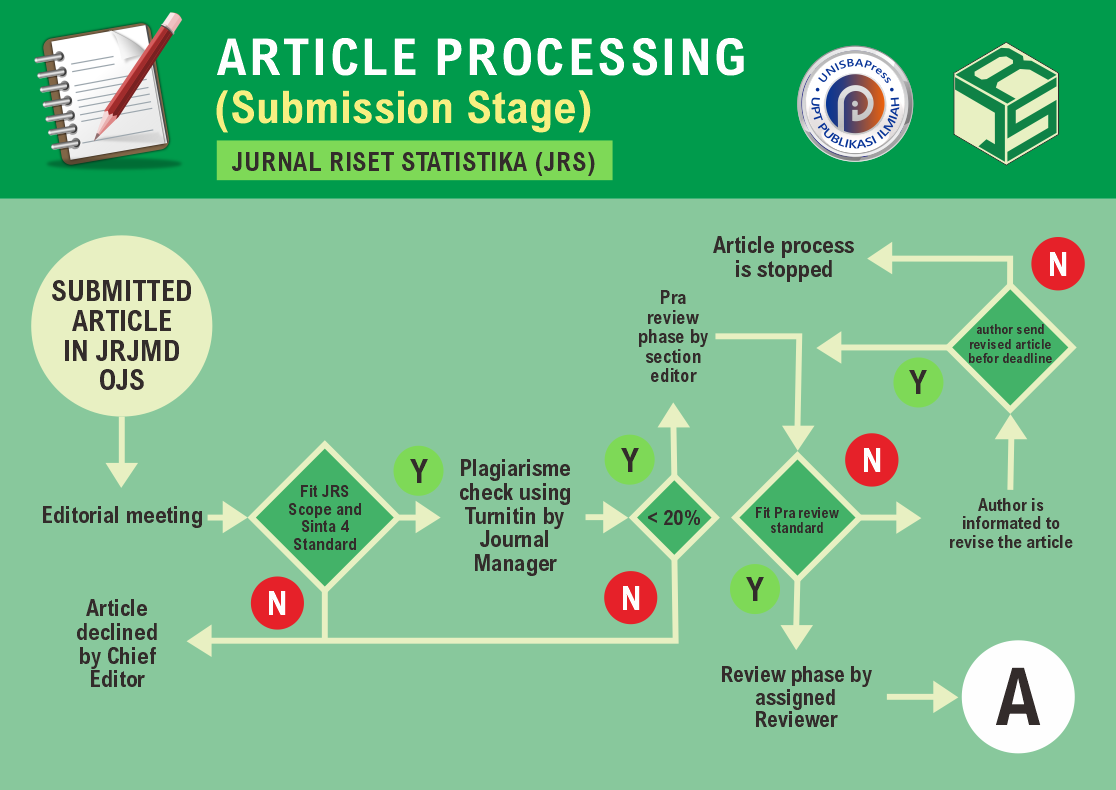Penerapan Regresi Spasial Panel Random Effect pada Kasus Kemiskinan di Provinsi Jawa Tengah Tahun 2011-2020
DOI:
https://doi.org/10.29313/jrs.v3i1.1885Keywords:
Regresi Spasial Panel, Random Effect, PovertyAbstract
Abstract. Spatial regression is a regression analysis that can be used to model data that focuses on a space or location (region). In spatial data, observations are often found at a location that has a relationship or influence with other adjacent locations. If the classical regression model is used as an analytical tool on spatial data, it can lead to inaccurate conclusions due to the assumption of mutual error (autocorrelation), the assumption of homogeneity is not met (heterogenity). To solve the problem, you can use the spatial regression panel random effect model. In determining the best model of spatial regression of panel data can use the Spatial Autoregressive or Spatial Lag (SAR) Random Effect and Spatial Error Model (SEM) Random effect model. To calculate the spatial effect, a spatial weighting matrix was used, in this study the spatial weighting matrix used was the Queen Contiguity spatial weighting matrix. The data used for the study used data on the percentage of poor people with free variables, namely life expectancy, adjusted per-capita expenditure, and average length of schooling. The results showed that the Spatial Error Model (SEM) Random Effect model is the best model, because it has the smallest AIC (Aikake Information Criterion) value and BIC (Bayessian Information Criterion) value. Based on the results of modeling with the Spatial Error Model (SEM) Random effect, the three factors affect the percentage of poverty in Central Java Province.
Abstrak. Regresi spasial adalah analisis regresi yang dapat digunakan untuk memodelkan data yang berfokus pada ruang atau lokasi (region). Pada data spasial sering dijumpai pengamatan pada suatu lokasi yang memiliki hubungan atau pengaruh dengan lokasi lain yang berdekatan. Jika model regresi klasik digunakan sebagai alat analisis pada data spasial, dapat menyebabkan kesimpulan yang kurang tepat karena asumsi error saling bebas (autokorelasi), asumsi homogenitas tidak terpenuhi (heterogeneity). Untuk mengatasi masalah tersebut dapat menggunakan regresi spasial panel random effect model. Dalam menentukan model terbaik regresi spasial data panel dapat menggunakan model Spatial Autoregressive atau Spatial Lag (SAR) Random Effect dan Spatial Error Model (SEM) Random Effect. Untuk menghitung efek spasial digunakan matriks pembobot spasial, dalam penelitian ini matriks pembobot spasial yang digunakan yaitu matriks pembobot spasial Queen Contiguity. Data yang digunakan untuk penelitian menggunakan data persentase penduduk miskin di Provinsi Jawa Tengah tahun 2011-2020 sebagai variabel terikat sedangkan variabel bebas yaitu usia harapan hidup, pengeluaran per-kapita disesuaikan, dan rata-rata lama sekolah. Hasil penelitian menunjukkan bahwa model Spatial Error Model (SEM) Random Effect merupakan model terbaik, sebab memiliki nilai AIC (Aikake Information Criterion) dan nilai BIC (Bayessian Information Criterion) terkecil. Berdasarkan hasil pemodelan dengan Spatial Error Model (SEM) Random effect ketiga faktor berpengaruh terhadap persentase kemiskinan di Provinsi Jawa Tengah.
References
L. Anselin, Spatial Econometrics: Methods and Models, vol. 4. Dordrecht: Springer Netherlands, 1988. doi: 10.1007/978-94-015-7799-1.
R. Y. Khoeriyah and N. Hajarisman, “Regresi Terboboti Geografis Semiparametrik (RTG-S) untuk Pemodelan Indeks Pembangunan Kesehatan Masyarakat Kabupaten/Kota di Sumatera Utara,” Jurnal Riset Statistika, vol. 1, no. 1, pp. 43–50, Oct. 2021, doi: 10.29313/jrs.v1i1.145.
A. S. N. Safitri, “Optimasi regresi spasial panel untuk pemodelan indeks pembangunan manusia di jawa tengah dengan menggunkan R dan ArcView,” Universitas Negeri Semarang, Semarang, 2018.
A. Widarjono, Ekonometrika Pengantar dan Aplikasinya, 3rd ed. Yogyakarta: Ekonesia, 2009.
BPS Jawa Tengah, “Kemiskinan Provinsi Jawa Tengah Maret 2020,” BPS Provinsi Jawa Tengah, 2021.
J. P. LeSage, The Theory and Practice of Spatial Econometrics. Ohio: University of Toledo, 1999.
J. P. Elhorst, Spatial Panel Data Models : Spatial Econometrivs From CrossSectional Data to Spatial Panels. New York: Springer, 2014.
J. P. Elhorst, Spatial Panel Data Models : Handbook of Applied Spatial Analysis. New York: Springer, 2009.
I. Tamara, D. Ispriyanti, and A. Prahutama, “Pembentukan Model Spasial Data Panel Fixed Effect Menggunakan Gui Matlab (Studi Kasus : Kemiskinan di Jawa Tengah),” JURNAL GAUSSIAN, vol. 5, no. 3, pp. 417–426, 2016, [Online]. Available: http://ejournal-s1.undip.ac.id/index.php/gaussian
Agresti A, An Introduction to Categorical Data Analysi. New York: John Wiley and Sons, 2007.













